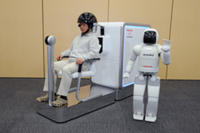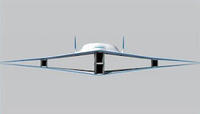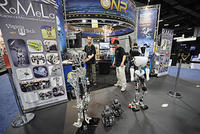-
Pentagon explores mind-controlled battle robots

Taking a page from the popular movie Avatar, the military’s advanced research arm DARPA is seeking to develop technology that would allow troops to remotely inhabit the bodies of mechanical androids on the battlefield
-
-
Smart grid: from deployment to applications
Some 200 million smart meters have been deployed worldwide, forty million of them in North America; a new white paper from Pike Research says that the year 2012 represents a turning point for the sector
-
-
Using people with cell phones as surveillance nodes
Eighty-eight percent of Americans now own a cell phone, forming a massive network that offers scientists a wealth of information and an infinite number of new applications; with the help of these phone users — and their devices’ cameras, audio recorders, and other features — researchers envision endless possibilities for gathering huge amounts of data
-
-
Bi-plane to revive supersonic travel

Researchers say that the best way to revive supersonic air travel – which came to an end with the retirement of the Concorde in 2003 – would be by building a plane with two wings to a side; computer models show that a bi-plan produces significantly less drag than a conventional single-wing aircraft at supersonic cruise speeds
-
-
Scientists develop a dirty bomb detection system
As part of a £3 million international project funded by the European Commission, scientists at the University of Liverpool are developing a mobile detection system for nuclear materials that could prevent the construction of atomic weapons and dirty bombs
-
-
Researchers developing wireless emergency network for disasters
University of Arkansas researchers are developing a solar powered wireless emergency communications network that can be deployed during major disasters to transmit critical warnings and geographic information
-
-
Killer silk kills anthrax, other microbes dead
A simple, inexpensive dip-and-dry treatment can convert ordinary silk into a fabric that kills disease-causing bacteria — even the armor-coated spores of microbes like anthrax — in minutes
-
-
Harvesting energy, water from human waste
Researchers begin developing prototype device for harvesting energy and clean drinking water from human waste; the device proposal beat more than 2,000 other proposals to receive funding from the Bill and Melinda Gates Foundation
-
-
Rethinking the toilet model in developing countries

More than 2.6 billion people around the world lack access to basic sanitation, and more than 40 percent of the world’s population lack access to even the simplest latrine; the lack of sanitation creates serious problems, including environmental pollution, unsafe surroundings, and increasing the outbreak of lethal epidemic diseases such as cholera; Swedish company offers a solution
-
-
Researcher develops highly sensitive, nanomaterial gas detector
A doctoral student at the Rensselaer Polytechnic Institute has developed a new sensor to detect extremely small quantities of hazardous gas
-
-
Universal Detection unveils radiation detection smartphone app
Last week Universal Detection Technology unveiled its first generation smartphone app designed to detect nuclear radiation levels on a variety of surfaces including food
-
-
New paper gas detectors developed
Researchers at the University of Michigan, Ann Arbor, have developed a quick and simple way to detect the presence of nerve gases
-
-
Origami-inspired paper sensor tests for malaria, HIV for less than 10 cents
Chemists have developed a 3-D paper sensor that may be able to test for diseases such as malaria and HIV for less than ten cents a pop; such low-cost, point-of-care sensors could be useful in the developing world, where the resources often do not exist to pay for lab-based tests, and where, even if the money is available, the infrastructure often does not exist to transport biological samples to the lab
-
-
Computer spots liars by looking at the way they talk
Computer scientists are exploring whether machines can read the visual cues of an individual’s conduct to discover whether or not that individual is lying; in a study of forty videotaped conversations, an automated system the researchers developed correctly identified whether interview subjects were lying or telling the truth 82.5 percent of the time
-
-
Robot for shipboard firefighting

In both war and peace, fire in the shipboard environment is serious and frequently results in excessive damage and high repair costs because the fire is not detected or controlled adequately; researchershave developed a humanoid robot that could fight fires on the next generation of combatants
-
More headlines
The long view
New Technology is Keeping the Skies Safe
DHS S&T Baggage, Cargo, and People Screening (BCP) Program develops state-of-the-art screening solutions to help secure airspace, communities, and borders
Factories First: Winning the Drone War Before It Starts
Wars are won by factories before they are won on the battlefield,Martin C. Feldmann writes, noting that the United States lacks the manufacturing depth for the coming drone age. Rectifying this situation “will take far more than procurement tweaks,” Feldmann writes. “It demands a national-level, wartime-scale industrial mobilization.”
How Artificial General Intelligence Could Affect the Rise and Fall of Nations
Visions for potential AGI futures: A new report from RAND aims to stimulate thinking among policymakers about possible impacts of the development of artificial general intelligence (AGI) on geopolitics and the world order.
Keeping the Lights on with Nuclear Waste: Radiochemistry Transforms Nuclear Waste into Strategic Materials
How UNLV radiochemistry is pioneering the future of energy in the Southwest by salvaging strategic materials from nuclear dumps –and making it safe.
Model Predicts Long-Term Effects of Nuclear Waste on Underground Disposal Systems
The simulations matched results from an underground lab experiment in Switzerland, suggesting modeling could be used to validate the safety of nuclear disposal sites.
